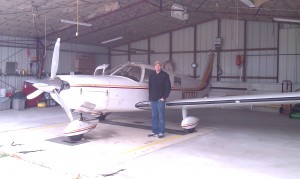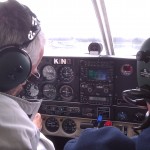 After nearly 3 years of flying Cessna 172’s and 152’s, the opportunity to fly a different airplane finally came along on April 30th 2012. The aircraft was a 1969 Piper Cherokee Six.
After nearly 3 years of flying Cessna 172’s and 152’s, the opportunity to fly a different airplane finally came along on April 30th 2012. The aircraft was a 1969 Piper Cherokee Six.
How did I get so lucky? The opportunity took almost 4 months to arrange. There is rarely a week that goes by where I do not talk with someone from work about flying. One of my favorite people to go “Hanger Flying” with is one of the salesmen, Jerry. He is a familiar face in the store and knows almost all of our regular customers. After talking about it for a few weeks, we I finally matched up our schedules and met at the airport for a flight. I like to think I help encourage his interest in airplanes but it is obvious he has always had the bug.
Another random morning a few weeks later, Jerry handed me a post-it note with a phone number and a N-Number written on it. The look of total confusion followed by intrigue on my face must have been apparent. Jerry began telling the story of one of his long-time customers Jim. Jim was a partner in a Flying Club that owned a Piper Cherokee Six at our local airport in West Bend Wisconsin. Jerry had flown with him in the past and shared his flight experiences with me. Jim was attempting to sell his Partnership in the club and I was willing to look at the airplane and fly it if possible.
After almost 4 months of phone tag, rescheduling and weather related delays Jerry, Jim and I finally had the opportunity to meet up for a flight in the Cherokee. On a Sunday in late April, we took off from West Bend headed for Baraboo/Wisconsin Dells. One of the most important questions you have to answer when you are NOT the Pilot-in-Command of the aircraft is; Do I want the front seat on the way there or on the way back. A quick check of the wind direction and I knew I wanted to sit in front for the return leg. The strong headwind would be me more time in the right seat and an opportunity to watch Jim act as PIC during the flight out.
 I watched closely as Jim did this pre-flight checklist. This was my first real opportunity to watch another pilot in action. Obviously I spent my share of time with flight instructors but this was different. It was an opportunity to watch another experienced pilot do their thing. Even for this short flight he was well organized and never rushed a step. After the engine run-up and pre-flight inspection was complete we taxied to runway 13 and lined up for takeoff. With the brakes on we went to full power and released the brakes. The most noticeable difference between the Cherokee Six and a typical training airplane is the horsepower. Of course it will have more “umpff” but you really only feel it while accelerating down the runway. Once airborne, I was delighted to see how similar the flight experience was to the trusty C172 I had flown many times before today.
I watched closely as Jim did this pre-flight checklist. This was my first real opportunity to watch another pilot in action. Obviously I spent my share of time with flight instructors but this was different. It was an opportunity to watch another experienced pilot do their thing. Even for this short flight he was well organized and never rushed a step. After the engine run-up and pre-flight inspection was complete we taxied to runway 13 and lined up for takeoff. With the brakes on we went to full power and released the brakes. The most noticeable difference between the Cherokee Six and a typical training airplane is the horsepower. Of course it will have more “umpff” but you really only feel it while accelerating down the runway. Once airborne, I was delighted to see how similar the flight experience was to the trusty C172 I had flown many times before today.
On the flight out I split my time between the scenery I had never noticed while flying the route as PIC and the avionics in the cockpit. The flight was a mere 32 minutes and we were at our destination. I knew from previous flight experience that the airport was difficult to spot from the air when arriving from the east and provided any assistance I could in helping Jim locate the airport and other traffic near the airport.
I watched closely as we entered the traffic pattern and setup for final approach. It appeared to be high and fast but who was I to judge, I was not the Pilot and I had never flown in this aircraft before. My suspicions were confirmed when the first bounce off the runway occurred until we finally slowed and settled onto the runway. It was encouraging to see another pilot make a less-than-perfect landing even with much more experience than I had. The landing served as a reminder of my flight lessons when Glenn, my Flight Instructor said “Every single landing is different. Don’t be discouraged by the less-than-perfect landings, learn from them”.
As we ate lunch I could not wait to get back to the airport for my shot at the front seat of the Cherokee Six. Jim walked through an abbreviated pre-flight check with me before we prepared to leave Baraboo and it prompted an interesting question. Do you return the fuel samples to the tank or dump them? I had always dumped them on the premise that any unseen contaminates or particles from the fuel test would not be returned to the tank. Jim’s was in the school of returning the fuel to the tank if there were no problems. The jury is still out on the correct answer for me.
As we lined up on the runway for the return leg of the flight, Jim gave me the airplane but followed along closely during the takeoff. After we were about 100 feet off the ground I saw Jim relax on the controls and I knew it was really me at the controls. This was a great moment! I was flying an airplane that I had not been in before and I still felt like I knew what was going on.
I continued the climb and turned on a heading for home. We were climbing at about 600 feet-per-minute and I wanted to do my best to climb to altitude and level out without overshooting. About 200 feet before my chosen altitude I started to reduce the climb rate and we leveled out within 50 feet of my target. Success! (it’s the little things in life). For the remainder of the flight I concentrated on heading and altitude hold in light to moderate turbulence. I managed to successfully hold heading within 10 degrees and altitude within 100 feet. I’m sure the professional pilots will laugh but I was proud of the small success.
The flight home was approximately 45 minutes with the headwind and I was happy to make the position reporting radio calls as we approached West Bend. As much as I would have liked to take it all the way to the runway, Jim needed to land this time because I was not trained or insured on this particular airplane. His approach and landing at West Bend Airport were flawless and I was impressed with the limited runway he used to land.
This flight experience was defiantly one for the log book. None of the flight time was actually logable but I use my log book to record all my flight related activities and this is one to remember. Before today I often looked at the other airplanes at the airport as something I would likely never fly but now I can’t wait to start my Complex/High Performance endorsement. The increased capabilities of these larger aircraft as compared to training aircraft make flying distances with family and friends possible even with their luggage. The Cherokee Six may be known as the station wagon of the sky but I wouldn’t feel any less manly behind the controls of this airplane.




